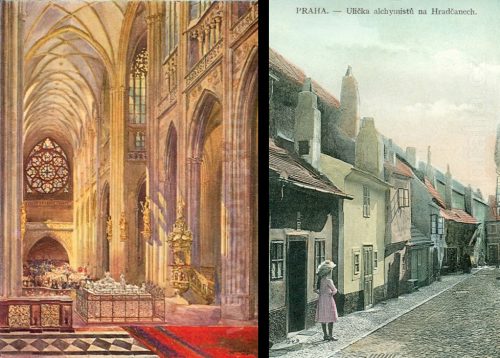Travels with Grace: On to Prague
Welcome to this week’s segment of our 2019 #TravelTuesday series: Traveling with Grace. Today we follow along as Grace heads into Prague during the summer of 1929.
August 18, 1929
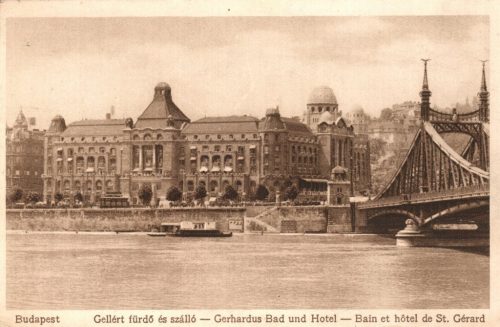
Gellert Hotel, vintage postcard. Via.
Spent some time in the pretty gardens of St. Gellerts baths and enjoyed watching the bathers in their very striking costumes and the waves in the pool are quite novel. A fine big hotel is operated here. On the hill opposite is a chapel in a natural grotto. Services broadcast tonight.
August 19, 1929
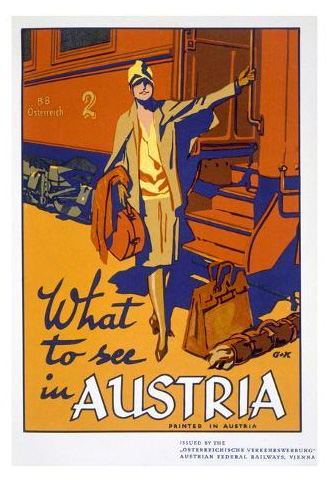
“What to see in Austria” travel poster, c. 1920s. Via.
We leave Budapest at 9 a.m. The city is in gala array, fan bedecked, and bunting hung, for St. Stephens day tomorrow. At the station we see peasants coming in droves all laden with heavy packs as if bringing all their provisions for a week. On the train they rent a radio earphone plugged in the compartment for about 25 cents and music is broadcast as far as the frontier. It was very warm in Budapest but gets much cooler as we near Vienna, arriving in the latter place at 2 p.m.
We go to Daniel’s for tea and them walk along the Kohlmarket where the shops are most attractive and view the interesting monument of the Trinity or Pestsaule erected by Leopold I as a thanks offering for deliverance from the plague about 1687. It was designed by Bermacini and is supposed to represent a cloud inhabited by an angel choir surmounted by a sunburst representing the Holy Ghost upheld by the Father and Son. I never saw so many beggars as are in Vienna. Tonight, I met a very interesting artist Mme. Schaetzel of Paris, at the hotel.
August 20, 1929
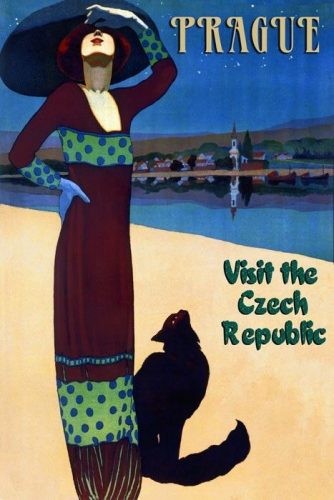
Reproduction, black cat vintage travel poster, Prague. Via.
Tuesday. Leave Vienna at 8 a.m. The train takes us through pretty farm country intersected frequently by lakes and rivers, arriving in Prague in a drenching rain at 2:30 p.m. Locate at Esplanade Hotel.
August 21, 1929

Bohemian National Museum, 1929. Via.
Wednesday. The weather is still disagreeable. We take a short walk, see the Bohemia National Museum (imposing exterior) and monument to Wenceslaus, 1st King of Bohemia. Then visit the clinic of the Prague general hospital. Very crude looking compared with ours. Dr. Merl very kind.
August 22, 1929
Thursday. We take a carriage this morning and ride through the Baumgarten, Prague’s beautiful park. It is quite natural, hilly and large in area. One section is devoted to flowers of which there are some beautiful varieties. Then we continue out through the new residential suburbs of Bubenec and Dejuice where the wealthy citizens have lovely garden villas. Prague is very large in extent, claims two million inhabitants. It is divided by the Moldau River, which flows into the Elbe, and joined by twelve fine bridges. This afternoon we take private auto and visit some of the venerable institutions of this very old and interesting city. We see the Powder Tower; Charles University; statue of Rabbi Lev, a renowned scholar of astronomy about which study he wrote many books and also helped fight against the Swedes. The statue, very unusual in treatment, occupies a prominent place on the cornice of the new Town Hall building. It is at the beginning of the old Jewish ghetto, where there dwelt six thousand Jews.
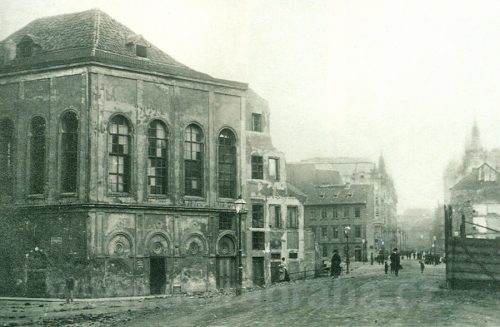
A view of the Velkodvorská (Grand Court) Synagogue, also called the Bassevi Synagogue. Via.
Here are two synagogues, one five hundred years old, the other fifteen hundred years old. The women were not allowed inside but had a separate building where they could open the windows and hear the services without seeing. There is a clock in this section bearing the Hebrew numerals and hands moving from right to left. The Jewish cemetery is the oldest in Europe, the tombstones black with age and many deep sunk in the ground. The oldest, that of Sara Katz, dates from year 606. Many of them bear crude images of animals whose names the Jews were forced to adopt by decree of King Joseph II, as a distinguishing mark.
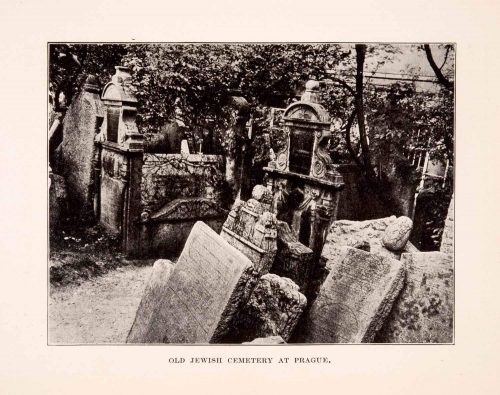
Old Jewish cemetery, Prague, 1929. Via.
In front of the old Town Hall, where the Unknown Soldier is buried, we watch the astronomical clock, with its complicated devices for marking off the hours, days, months, seasons, etc., strike the hour of three. Three of the twelve apostles follow Christ before two windows which swing open as the clock begins to strike, then a skeleton pulls the string for the cock to crow three times. Nearby is the John Hus monument with striking group of large bronze figures on a granite base. We see the Parliament building and cross the oldest stone bridge, Charles IV, six hundred years old, on which are thirty statues, one of which represents Christ encircled with an inscription in Hebrew gilded letters, about which diverse legends cluster. Another remarkable group illustrates St. Wenceslaus freeing the slaves. At one end of the bridge is a beautiful Gothic memorial to King Charles IV. There are many picturesque old town gates and towers.
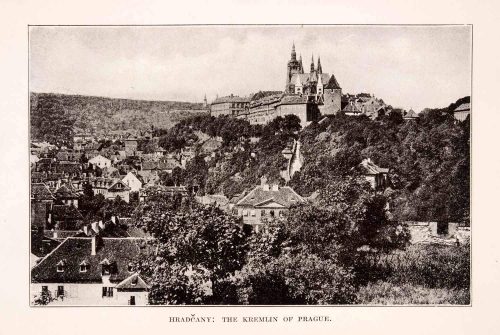
Hradcany castle district of Prague, 1929. Via.
We ride through a section occupied by the former private palaces of the nobility now converted for the most part into foreign legations and state ministries, and up on the hill where stands the beautiful old Castle of Prague and the Cathedral of St. Vitus, one of the finest I have seen anywhere, in pointed Gothic with flying buttresses and gargoyles. The afternoon sun pouring through the lovely stained-glass windows casts rainbow hues upon the pavement. I notice two pretty peasants entering here most attractively garbed, one in yellow, the other in a pink skirt of stiff brocaded satin with white brocaded silk kerchiefs on their heads. From the castle hill we enjoy a fine panorama of the city, the great number of steeples, said to be one hundred, impressing the observer. From the nearby bell tower of Loretto church we hear the sweet carillon toll the hour of five.
In the quaint little Zlata Ulicka, or Golden Lane, we have the pleasure of looking into several homes, the smallest I ever saw; from the rear they look out upon the castle gardens. In one room, 4×6 feet and about 6 feet high, four people live. They sleep on a high feather bed and a couch. It is immaculate and contains some colorful examples of needlecraft. There is only one other room, a kitchenette, smaller still, about 2×4 feet. Around the castle grounds is a crenelated wall because, so the story goes, they were dying of hunger for lack of employment and built this wall as a means to obtain food.
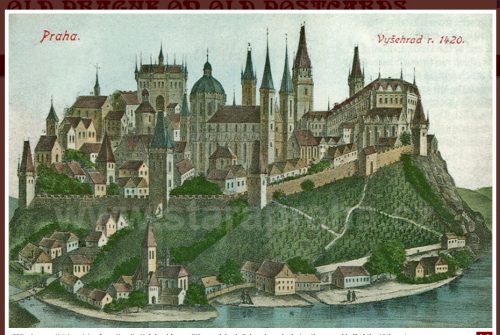
“A romanticizing vista of pre-Hussite Vyšehrad from a lithograph by A. Pokorný, made during the second half of the 19th century.” Via.
We ride through several new suburban sections, where building is proceeding at a brisk pace where three years ago there were only fields Some of the houses are of eccentric cubistic design and some have designs of birds, flowers, etc. appliqued on stucco which remind me of material all over embroidered. One street is named for Charlotte Masaryk, deceased wife of the president and her bust appears in marble in a niche on one of the houses. The Komensky memorial is another of the fine statuary groups with which the city abounds. There are several islands in the river. Some of the old houses along the banks are standing right in the water and as one looks down from the bridge one catches vistas strongly reminiscent of Venice. Male Namesti is the center of the most ancient part of Prague and the lower parts of some of the houses date from the 12th and 13th centuries. In Vysehrad we see the fortifications of the old Citadel of the 17th century with the Tabor and the French gates. The burying ground of some of the famous men and women of this country lies here. We return to the hotel via the new quarter, Karloske Vinohrady where are the National Theater and some fine museums and libraries.
August 23, 1929
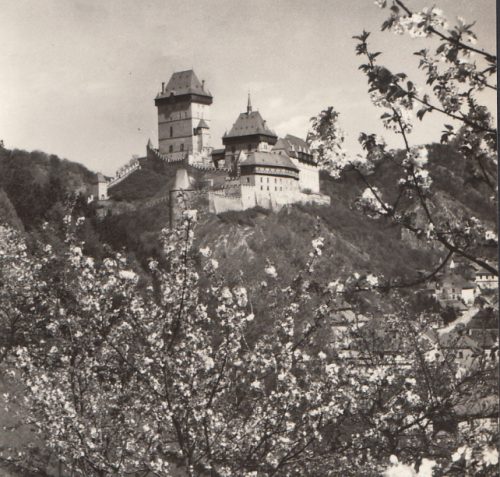
Hrad Karlstejn – resting place of Charles IV. Via.
Friday. We go by automobile to Karlsteyn where a large, spruce-forested park and on a commanding height stands the old, fortified medieval stone castle of Charles IV of whom there are so many reminders in Prague. The cornerstone was laid in the XIII century. There are chapels lined with semiprecious stones and fine examples of old mural paintings. Kettner called today.
August 24, 1929
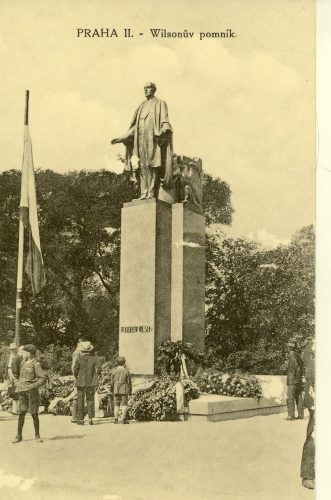
Monument to Woodrow Wilson, Prague. Via.
Saturday. Today we sit in the pretty little park named for Woodrow Wilson. Tonight Mr. and Mrs. Kettner and their two sons spend some time with us.
Thanks for reading “Traveling with Grace,” a series where we’re sharing (and annotating) posts from the travel diaries of Grace Amelia Hecht, native Baltimorean, b. 1897 and d. 1955. As mentioned in my introductory post transcription errors sometimes occur and I’ve made my best guesses where possible, denoted by [brackets]. – Rachel Kassman, marketing manager

